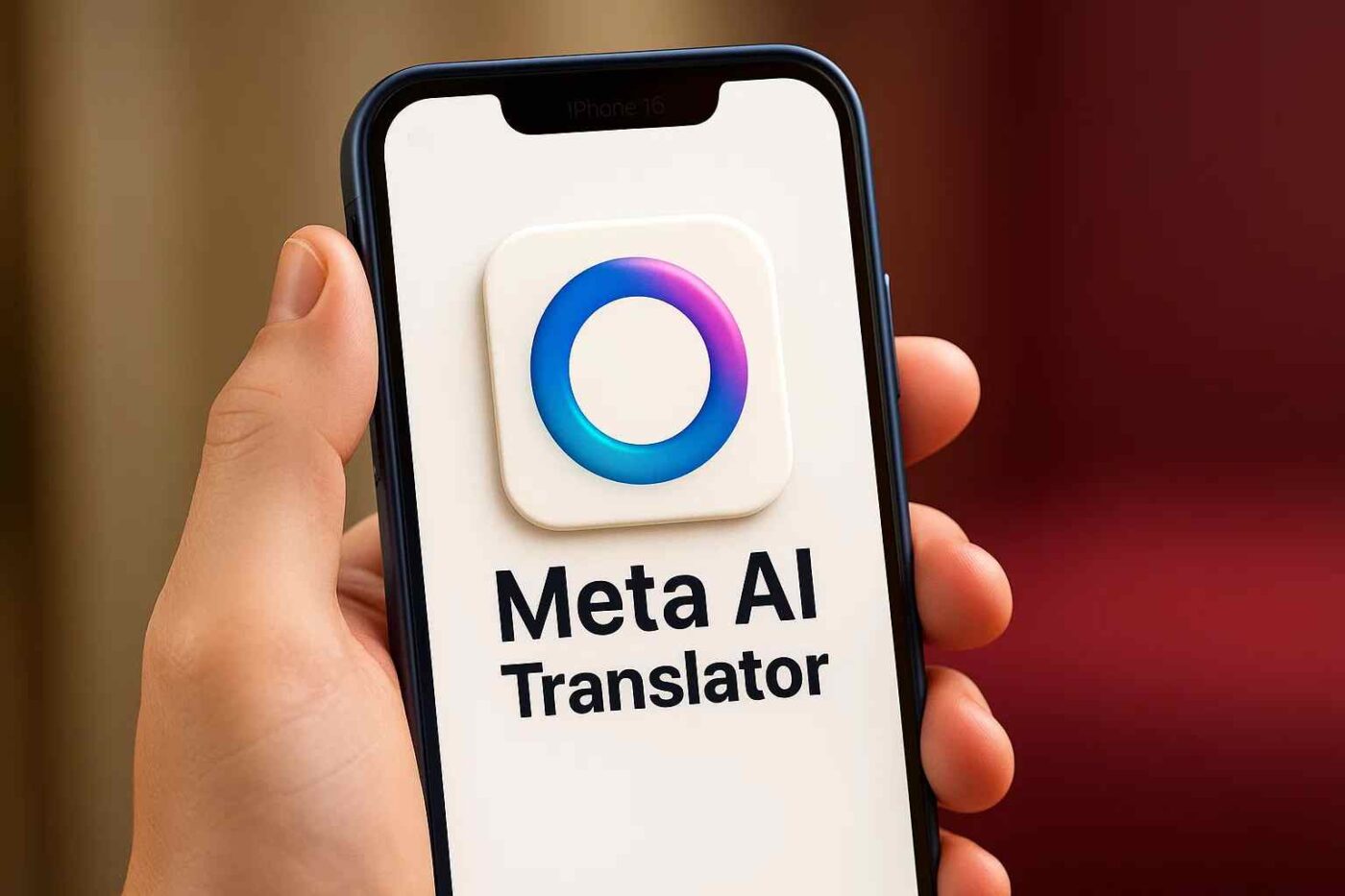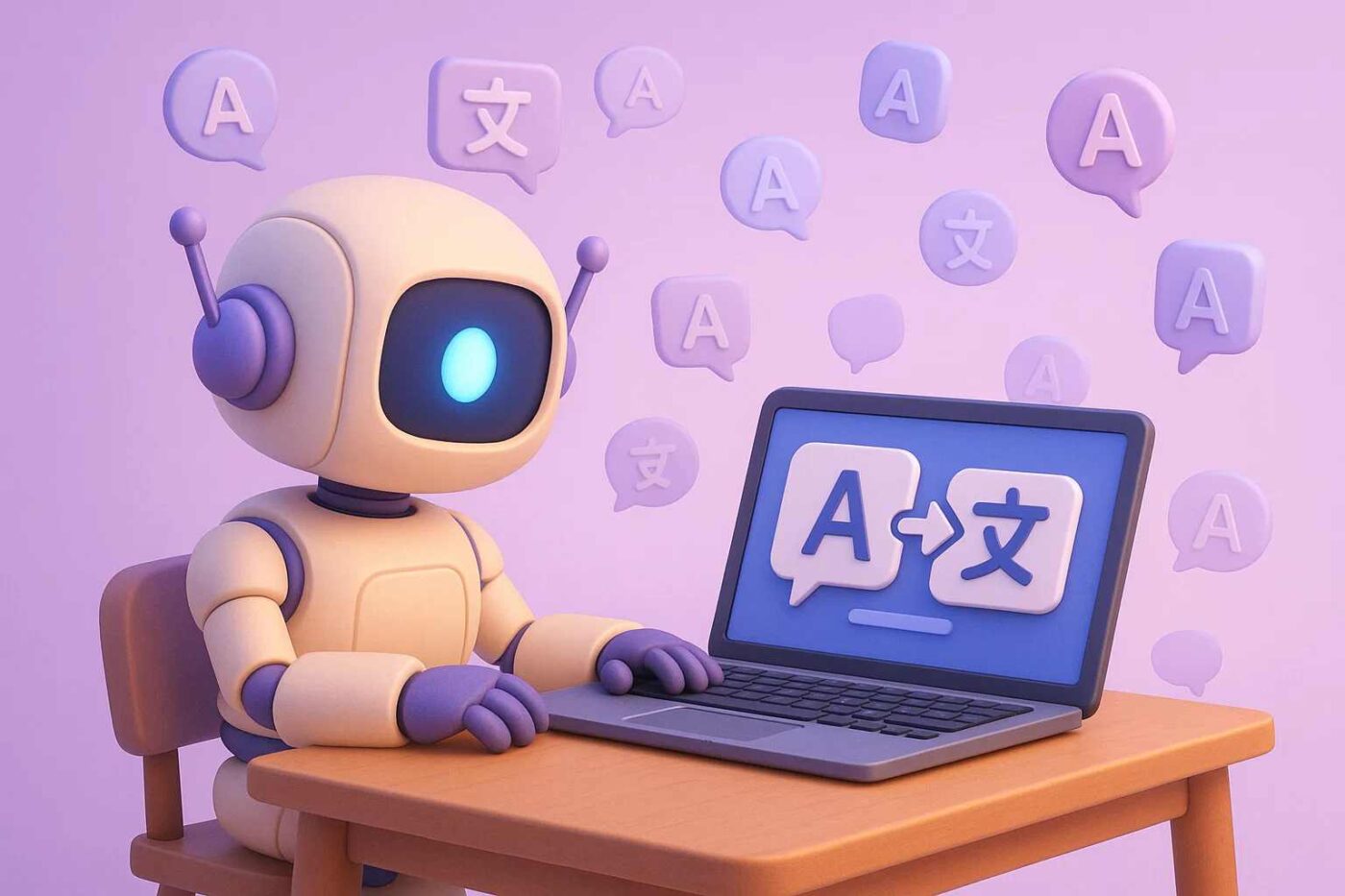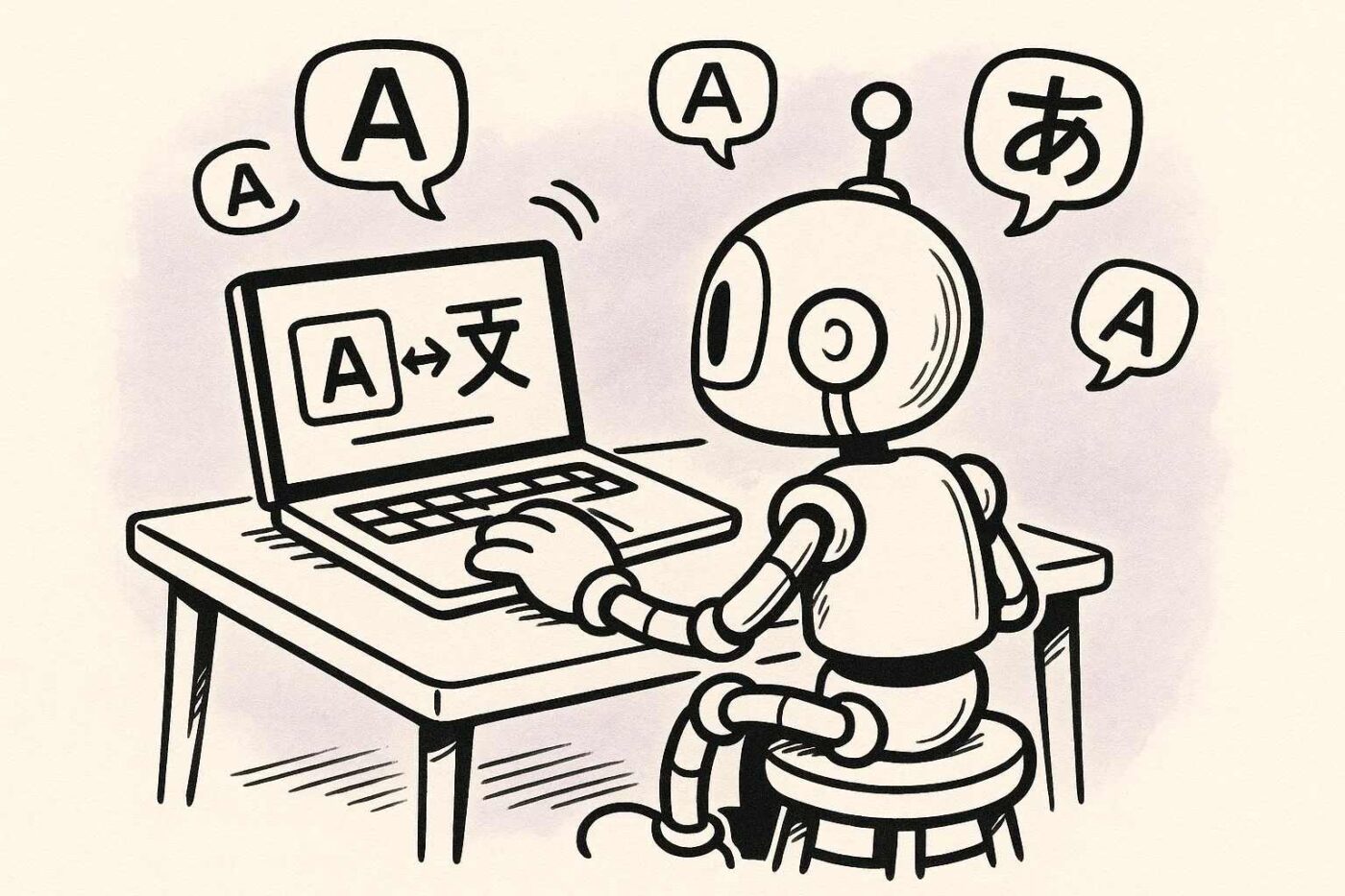AI Translation: Google Translate vs ChatGPT vs DeepL vs Gemini
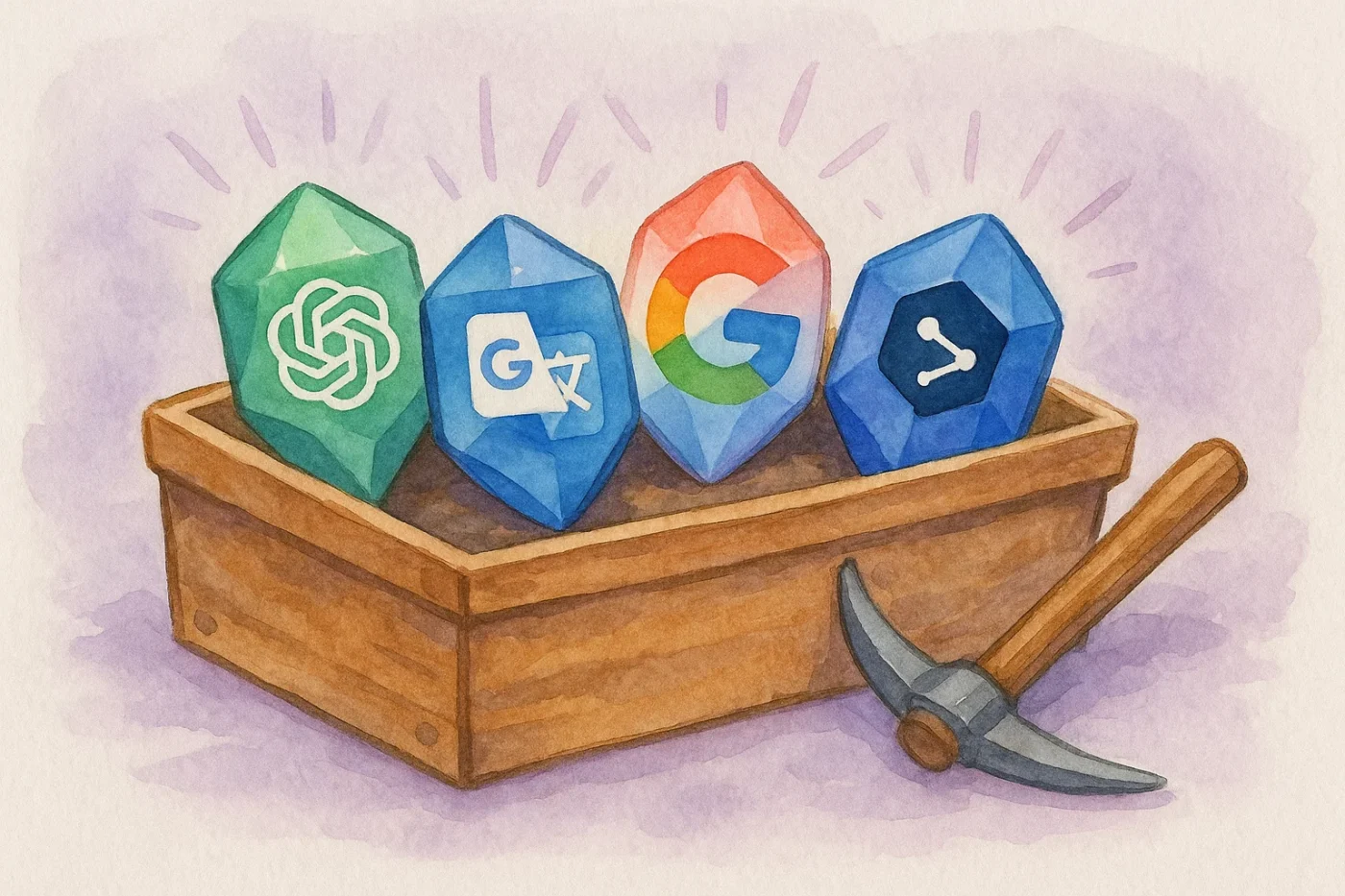
AI translation has been around for quite some time, but only recently people started using it professionally in their jobs and businesses.
AI translation tools evolved at super sonic speed, and this begs the question: “Which one is the best?”
Today we will answer this exact question and we will compare the 4 best translators:
- Google Translate
- ChatGPT
- DeepL
- Gemini
Or, if you want an all-in-one solution, that combines all the best AI translation tools on the market, and then puts everything through a Quality Assurance filter… go with Ovesio,com
Ovesio integrates Google Translate, Microsoft Translator, OpenAI, DeepL and Gemini, all under the same hood.
Each piece of text is translated with all the translators, and then the Ovesio AI Inspector chooses the best parts from each version. Thid way, Ovesio compiles the most accurate AI translation.
Let’s jump right in!
I. Introduction: The Battle of AI Translation Tools
In the past decade, artificial intelligence has revolutionized the way we break language barriers.
What began as basic, word-for-word translations has evolved into sophisticated systems capable of understanding context, tone, and nuance.
From casual conversations to professional documents, AI translation tools have become indispensable in our hyperconnected world.
Some companies are even developing ai translation earbuds which are not that great right now, but that’s how each tech innovation starts.
Four key players currently dominate this space: Google Translate, DeepL, ChatGPT, and Gemini. Each brings a unique strength to the table, whether it’s Google’s unmatched language coverage, DeepL’s precision, ChatGPT’s contextual depth, or Gemini’s growing potential within integrated ecosystems.
We will compare these AI translation platforms across core technologies, translation accuracy, language coverage, speed, and real-world usability. Whether you’re a business leader, student, or traveler, understanding the strengths and trade-offs of each tool will help you make an informed decision.
Key takeaway upfront:
DeepL shines in precision and naturalness, Google Translate leads in accessibility and speed, ChatGPT excels in contextual understanding, and Gemini is the rising wildcard showing strong integration and promise.
II. Core Comparison: How Each Platform Translates in the Real World
A. Technology & Architecture
Each translation app is built on a distinct AI foundation that shapes how it handles language tasks:
- Google Translate relies on Neural Machine Translation (NMT), a model trained on massive multilingual datasets. NMT excels at rapid processing and covers more than 130 languages. Its architecture is tuned for speed, scale, and integration across the Google ecosystem.
- DeepL uses a proprietary neural network architecture focused on linguistic nuance and semantic accuracy. Unlike traditional NMT, DeepL’s design pays close attention to intent and tone, producing translations that often sound more human and contextually appropriate, particularly in European language pairs.
- ChatGPT is powered by OpenAI’s GPT-4 architecture, a large language model trained through reinforcement learning with human feedback (RLHF). This makes ChatGPT uniquely equipped to interpret context, handle non-literal language, and adjust to cultural subtleties during translation.
- Gemini, Google’s newest multimodal model, is engineered for context-aware, real-time translation across multiple content types (text, audio, and more). It brings AI-powered reasoning and sentence-level comprehension to translation, though its language support is still growing.
B. Translation Accuracy
Accuracy is the most crucial metric in evaluating a translation tool, especially when meaning, tone, and nuance matter.
- DeepL consistently earns top marks in professional evaluations. Blind tests by translators show it produces the most natural and accurate output, particularly for European languages. DeepL also outperforms competitors in BLEU and COMET scoring benchmarks, requiring fewer post-edits than both Google Translate and ChatGPT.
- ChatGPT (GPT-4) proves especially strong in preserving meaning and understanding idiomatic or culturally specific language. In one double-translation benchmark, ChatGPT had only 9 changes from the original, compared to 28 for Google Translate, highlighting its strength in semantic retention.
- Google Translate offers fast, functional translations but tends to sacrifice subtlety. It often defaults to more formal or literal phrasing and may misinterpret intent in complex or creative texts. However, its accuracy is still strong in high-resource languages like English, Spanish, and Korean.
- Gemini shows solid context-aware translation in supported languages, especially within Google Workspace environments. However, its accuracy is currently limited by its narrower language range and early-stage deployment.
C. Language Coverage & Speed
When it comes to translating across a broad set of languages at high speed, Google dominates:
- Google Translate supports over 130 languages, making it the most accessible platform globally. It’s optimized for instant translations, including real-time voice, camera, and offline modes. Its processing speed is among the fastest in the market, with sub-second latency in most cases.
- DeepL, in contrast, supports 33 languages, prioritizing quality over quantity. While slightly slower, processing a segment may take close to 1 second, its translations are typically more accurate and natural, making it ideal for professional and literary use.
- ChatGPT can translate over 100+ languages, but with varying accuracy. It shines in conversational and adaptive translations, but performance dips in lower-resource language pairs. Speed is decent but varies based on usage tier and interface (e.g., web vs. API).
- Gemini currently supports seven key languages in its translation features, German, Spanish, French, Italian, Japanese, Korean, and Portuguese. While the coverage is narrow, Gemini’s integration with Google Workspace and context-driven output provides a unique advantage for collaborative, enterprise-level tasks.
III. Beyond Words: Features, Privacy & Use Case Fit
A. Features & UX
When it comes to usability, each translation app offers a distinct mix of features tailored to different user needs:
- Google Translate stands out for its practicality. It supports instant camera translation, voice input, and offline mode, making it ideal for travelers and casual users. With features like handwriting recognition and website translation, it’s designed for everyday convenience.
- DeepL caters to professionals with powerful tools such as document translation that preserves formatting, custom glossaries for consistent terminology, and style settings in DeepL Write. The interface is clean and focused, appealing to users looking for streamlined, high-accuracy workflows.
- ChatGPT brings unmatched interactivity. Unlike static translators, ChatGPT can refine translations through follow-up prompts, similar to working with a human. It can also translate text from images, transcribe audio, and even summarize or rewrite translations for different audiences. This versatility makes it ideal for educational, marketing, and creative contexts.
- Gemini, while newer, is gaining traction through its seamless integration with Google Workspace. It enables multilingual collaboration across Gmail, Docs, and Slides, automatically translating content in real time. Though feature-limited compared to others, its native productivity integration is a major asset for enterprise users.
B. Security & Data Privacy
Security is increasingly critical, especially in industries handling sensitive information:
- DeepL Pro leads with its enterprise-grade data protection. Translations under Pro plans are not stored, reused, or accessed for training purposes. This makes it a top choice for companies handling confidential legal, medical, or financial documents.
- Google Translate and ChatGPT offer varying levels of privacy depending on account type and platform usage. Google’s data may be logged for improvement purposes, while OpenAI has recently introduced user data controls and business plans with stronger privacy protections. However, default usage may not meet strict compliance standards.
- Gemini benefits from being housed within Google Workspace, which is SOC 2-compliant and designed with enterprise-level security. However, Gemini’s translation features are not yet fully transparent in how data is processed across apps, so sensitive use cases should be approached cautiously until more detailed policies are clarified.
C. Sector-Specific Strengths
Different sectors demand different translation priorities, and not all tools are created equal in this regard:
- Business & Professional Use:
DeepL is the clear winner for high-stakes professional communication. Its contextual accuracy, formatting preservation, and customizable glossaries make it ideal for reports, contracts, and marketing copy. - Legal & Healthcare:
In sectors where accuracy and compliance are essential, human translators still outperform AI, but DeepL and secure hybrid systems (e.g., SOC 2-compliant platforms) come closest. MachineTranslation.com’s Secure Mode, often built on DeepL or similar LLMs, is emerging as a safe AI solution for sensitive content. - Creative & Educational:
ChatGPT thrives in creative and educational settings. It handles slang, idioms, and cultural nuance far better than most, and can adjust tone and style interactively, great for language learners, marketers, or content creators. - Travel & Everyday Use:
Google Translate is the most versatile for casual, on-the-go use. With its camera, voice, and offline capabilities, it’s the easiest to use in restaurants, airports, and real-time conversations. - Integrated Workflows:
Gemini is best suited to corporate users deeply embedded in Google Workspace. It enables dynamic multilingual communication across documents and emails, saving time in team collaboration and project management.
IV. Verdict: Which Should You Choose and Why
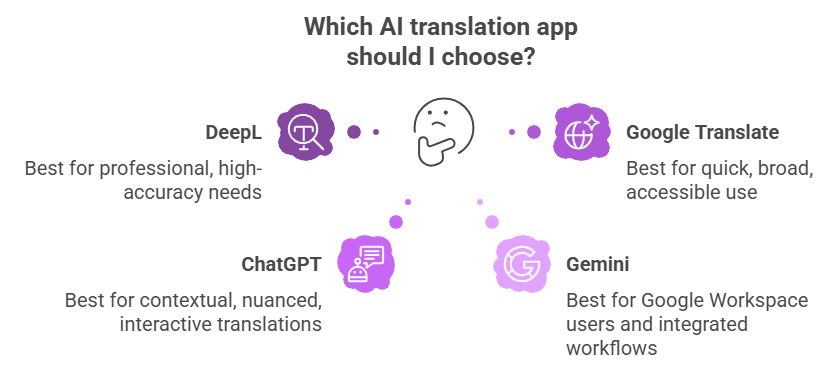
Ultimately, the “best” AI translation app depends on what you’re trying to accomplish. Here’s the breakdown by need:
🏆 DeepL: Best for Professional, High-Accuracy Needs
If you’re translating contracts, reports, technical documentation, or any content where accuracy and tone are non-negotiable, DeepL is your best bet. It consistently receives the highest scores in professional benchmarks and offers features built for precision and privacy.
🌍 Google Translate: Best for Quick, Broad, Accessible Use
With support for 130+ languages, instant camera translation, and offline functionality, Google Translate is perfect for everyday users, travelers, and anyone who values speed and convenience over perfect nuance.
🧠 ChatGPT: Best for Contextual, Nuanced, Interactive Translations
If your content requires creative interpretation, cultural adaptation, or ongoing collaboration, ChatGPT offers a level of contextual understanding unmatched by traditional tools. It’s ideal for educators, marketers, and creative writers looking for flexibility.
🔗 Gemini: Best for Google Workspace Users and Integrated Workflows
If your team is deeply invested in Google Docs, Sheets, or Gmail, Gemini is a promising translation companion. Its real-time, context-aware capabilities enable smooth, collaborative multilingual communication, though language support is still expanding.
V. Conclusion: The Future of AI Translation
The AI translation industry is not just evolving, it’s exploding. With projections estimating the market will exceed $1.3 trillion by 2029, it’s clear that multilingual communication is no longer a luxury but a strategic necessity in business, education, and global connectivity.
Each of the major players, DeepL, Google Translate, ChatGPT, and Gemini, is carving out a unique path:
- DeepL continues to dominate the professional landscape, offering unmatched precision and security that resonate with businesses and linguists demanding top-tier output.
- Google Translate is doubling down on accessibility and integration, enhancing its utility through AI-powered features and real-time translation tools that work across the Google ecosystem.
- ChatGPT is redefining what translation can mean, blending creativity, nuance, and interaction in a way no other platform currently matches.
- Gemini, though still maturing, is positioning itself as the go-to solution for integrated, context-aware translations within collaborative workflows, especially for Google Workspace users.
The Final Word
There’s no single “best” AI translation app, because there’s no single type of translation user.
The right tool depends on what you’re translating, why, and for whom.
Whether you need speed, accuracy, contextual understanding, or enterprise integration, the best choice is the one aligned with your goals, content, and context.
As the technology continues to improve, expect these platforms to become even more specialized, and, perhaps, even more complementary.
In the end, the future of AI translation is not about replacing human intelligence, but enhancing it, intelligently.
If you’re into AI tools and E-Commerce, here’s a blog article you’ll love: What Are the Best AI Tools for Ecommerce in 2025? (Top 5)



